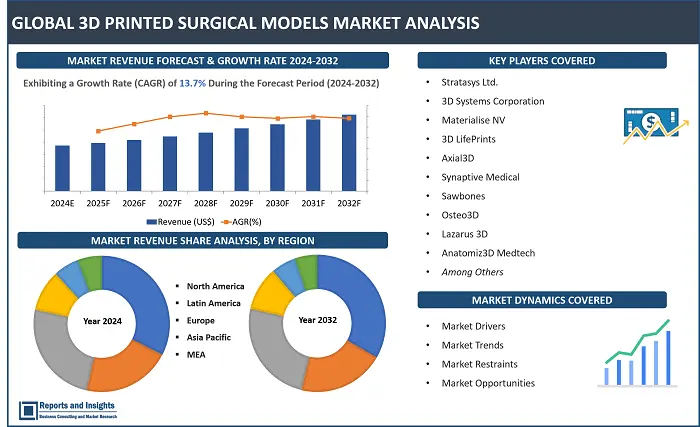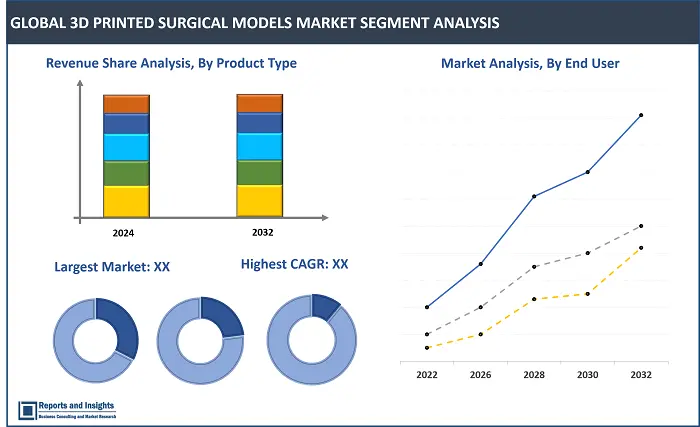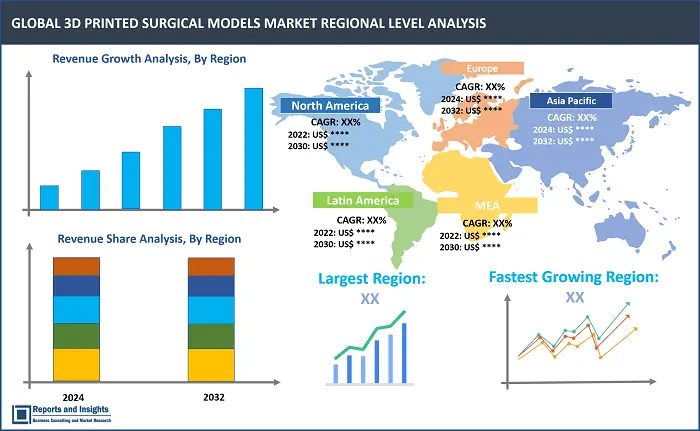Market Overview:
"The 3D printed surgical models market size reached US$ 456.4 million in 2023. Looking forward, Reports and Insights expects the market to reach US$ 1,449.4 million by 2032, exhibiting a growth rate (CAGR) of 13.7% during 2024-2032."
|
Report Attributes |
Details |
|
Base Year |
2023 |
|
Forecast Years |
2024-2032 |
|
Historical Years |
2021-2023 |
|
Market Growth Rate (2024-2032) |
13.7% |
3D printed surgical models are cutting-edge replicas of patient-specific anatomies created through advanced additive manufacturing techniques. This technology utilizes high-resolution medical imaging, such as CT scans or MRIs, to produce highly accurate, personalized models for surgical planning and training. The models, constructed from materials mimicking human tissue properties, enable surgeons to practice and refine their techniques before entering the operating room. This innovative approach finds applications across various medical specialties, including orthopedics, neurosurgery, and cardiology.
Major advantages include enhanced preoperative planning, reduced surgical risks, and improved patient outcomes. The realistic tactile feedback and anatomical fidelity of these models not only benefit surgeons but also serve as invaluable educational tools for medical professionals. As the industry progresses, 3D printed surgical models continue to revolutionize healthcare by promoting precision, efficiency, and safety in complex surgical procedures.
Factors driving market revenue growth include increased adoption in complex surgeries, enhanced patient-specific care, and advancements in material sciences refining model accuracy. Some key trends expected to drive market growth between 2024 and 2032 include expanded applications in medical education, regulatory advancements ensuring safety and quality standards, and increasing collaborations between healthcare institutions and technology providers.

3D Printed Surgical Models Market Drivers and Trends:
Utilization of 3D printed surgical models allows for personalized and precise surgical planning, reducing risks and improving outcomes surgeons can simulate and strategize complex procedures on patient-specific anatomical replicas, ensuring a higher level of preparedness. Furthermore, continuous innovations in 3D printing materials, closely mimicking human tissue properties, contribute to the realism and functionality of surgical models. This enhances the accuracy of simulations, providing surgeons with a more authentic and valuable training experience. 3D printed surgical models serve as invaluable tools for medical education, enabling students and healthcare professionals to practice procedures in a risk-free environment. This fosters skill development, ultimately improving the quality of patient care.
Companies are strategically engaging in collaborations with healthcare institutions and technology providers, these partnerships facilitate the development of integrated solutions, combining expertise to advance the field and bring innovative products to the market. Adherence to regulatory guidelines ensures the safety and quality of 3D printed surgical models. Companies are deploying strategies to meet and exceed these standards, building trust among healthcare professionals and institutions, and driving widespread adoption.
3D Printed Surgical Models Market Restraints:
The initial investment in 3D printing technology and materials can be relatively high for some healthcare institutions. This financial barrier may hamper wider adoption, particularly for smaller or resource-constrained facilities. The lack of standardized processes and regulations for 3D printed surgical models raises concerns about quality control and consistency. Healthcare professionals may be hesitant to fully embrace this technology without clear guidelines, potentially slowing down market growth. The effective utilization of 3D printed surgical models requires technical expertise. Training healthcare professionals on the use of this technology and incorporating it seamlessly into existing workflows can be time-consuming, acting as a restraint on rapid adoption. Integrating 3D printing into existing healthcare systems and workflows can be complex. Compatibility issues with imaging technologies and electronic health records may slow down the seamless incorporation of 3D printed surgical models into everyday clinical practice. Despite the benefits, there may be a lack of awareness among healthcare professionals about the capabilities and applications of 3D printed surgical models. Education and awareness initiatives are crucial to overcoming this challenge and driving broader adoption.
3D Printed Surgical Models Market Opportunities:
Leading players can capitalize on the opportunity to develop customized training programs for healthcare professionals. by offering comprehensive training and certification courses on the use of 3D printed surgical models, companies can ensure a skilled workforce, and encourage increased adoption and loyalty among users. Investing in research and development to expand the range of 3D printing materials will provide leading players with a competitive edge. Offering a diverse selection of materials that closely mimic various tissue properties enhances the realism and functionality of surgical models, catering to a wider range of medical specialties. Forming strategic partnerships with imaging technology providers and healthcare institutions can lead to the development of integrated solutions. Seamless integration with existing medical imaging systems enhances the overall workflow, making it more efficient and appealing to healthcare professionals.
Proactively addressing regulatory concerns and actively participating in the development of industry standards can position leading players as trustworthy and compliant partners. Striving for and achieving regulatory approval will build confidence among healthcare professionals, encouraging broader adoption of these solutions and surgical models. Leading players can explore opportunities for market expansion in regions with untapped potential. Investing in marketing efforts, establishing local partnerships, and tailoring products to meet regional healthcare needs can unlock new markets and drive significant revenue growth.
3D Printed Surgical Models Market Segment Analysis:

By Technology:
- Fused Deposition Modeling
- Stereolithography
- Selective Laser Sintering
- PolyJet Printing
- Others
Fused Deposition Modeling (FDM) segment is expected to account for largest revenue share owing to cost-effectiveness and wide adoption in various industries, including healthcare. Popularity of FDM is also supported by ability to create accurate anatomical models at a lower cost compared to other technologies. Also, accessibility, ease of use, and versatility of FDM printers make these solutions more appealing in healthcare institutions and also serves those seeking economical solutions for surgical planning and training. In addition, FDM allows for the use of a variety of materials, further enhancing its applicability across different surgical specialties.
By Material Type:
- Plastic
- Metal
- Biological Materials
- Ceramics
- Others
The plastic segment is expected to continue to account for largest revenue share among the material type segments as plastic is more widely used in 3D printing due to cost-effectiveness, versatility, and ability to mimic various anatomical structures. Plastic materials are commonly used in surgical models as the material offers a good balance between accuracy and affordability, making end-products accessible to a broader range of healthcare institutions. The development of advanced plastics with improved biomechanical properties has further enhanced their suitability for surgical simulation. Also, the customization potential of plastic materials aligns with the need for patient-specific models, contributing to their sustained adoption.
By Application:
- Orthopedic Surgery
- Neurosurgery
- Cardiac Surgery
- Dental and Maxillofacial Surgery
- Others
The orthopedic surgery segment is expected to account for largest revenue share over the forecast period, as adoption is relatively high due to the complexity of procedures and the need for precise preoperative planning. 3D printed orthopedic models provide surgeons with the means to practice and refine their techniques in a patient-specific context, leading to improved outcomes. Also, increasing prevalence of orthopedic conditions, coupled with rising demand for personalized healthcare solutions, is expected to continue to support demand and revenue growth of this segment. In addition, the versatility of 3D printing technology allows for the creation of intricate orthopedic models that closely replicate bone structures and pathologies, enhancing their value in surgical education and training.
By End-User:
- Hospitals
- Ambulatory Surgical Centers
- Academic and Research Institutes
- Contract Research Organizations
- Others
Among the end-user segments in the 3D printed surgical models market the hospitals segment is expected to account for the largest revenue share in 2024 and expected to maintain its dominance during the forecast period.
By Product Type:
- Anatomical Models
- Surgical Instruments
- Procedural Models
- Implants
- Others
By Region:

North America:
- United States
- Canada
Asia Pacific:
- China
- India
- Japan
- Australia & New Zealand
- Association of Southeast Asian Nations (ASEAN)
- Rest of Asia Pacific
Europe:
- Germany
- The U.K.
- France
- Spain
- Italy
- Russia
- Poland
- BENELUX (Belgium, the Netherlands, Luxembourg)
- NORDIC (Norway, Sweden, Finland, Denmark)
- Rest of Europe
Latin America:
- Brazil
- Mexico
- Argentina
- Rest of Latin America
The Middle East & Africa:
- Saudi Arabia
- United Arab Emirates
- South Africa
- Egypt
- Israel
- Rest of MEA (Middle East & Africa)
In North America region, the U.S. healthcare system is characterized by a high level of technological adoption and innovation, and strong emphasis on advanced medical practices is a key trend positioning the country ahead of other countries in the global market. Surgeons in the US are early adopters of cutting-edge technologies, including 3D printing, recognizing the benefits it offers in terms of personalized surgical planning and training. Also, the US has a robust research and development ecosystem, with numerous academic and research institutions actively engaged in advancing medical technologies. This encourages and drives collaboration between healthcare professionals, researchers, and 3D printing companies, leading to the development and refinement of 3D printed surgical models. In addition, the US is a large market for medical education and training, with continuous demand for advanced tools and techniques. 3D printed surgical models serve as invaluable educational aids, attracting adoption among medical schools, training centers, and healthcare institutions.
In Europe, increasing focus on personalized medicine and patient-specific care across the healthcare system and landscape is among the primary trends expected to boost demand for 3D printed surgical models in countries in Europe. These models allow for precise preoperative planning tailored to individual patients, thereby improving surgical outcomes. Also, collaborative efforts between healthcare institutions, academic centers, and 3D printing companies in Europe drive innovation, and joint initiatives are expected to result in advanced applications and materials, enhancing the realism and functionality of surgical models. In addition, rising emphasis on medical education and training in Europe is driving the integration of 3D printed surgical models into academic curricula, providing hands-on learning experiences for aspiring surgeons. Moreover, the alignment of regulatory frameworks in certain countries in the region with the adoption of innovative medical technologies is expected to facilitate smoother incorporation of 3D printed surgical models into clinical practice.
In Asia Pacific region, the expanding healthcare sectors mainly in India and China present significant market opportunities, and China and India are witnessing increased demand for advanced medical technologies, including 3D printed surgical models, as healthcare infrastructure continues to expand. Also, large populations in both countries, coupled with rising healthcare awareness, creates a substantially large and receptive market for medical education and training. Companies investing in these markets can develop strategic partnerships with educational institutions, providing 3D printed surgical models for training purposes and build long-term relationships with future healthcare professionals. In addition, the relatively lower cost of production and the availability of skilled labor in China and India make these economies attractive manufacturing hubs for 3D printed medical models. This can lead to cost-effective production and, consequently, competitive pricing, making the technology more accessible to a wider range of healthcare institutions.
Moreover, increasing focus on healthcare infrastructure development in several Middle Eastern countries, including the United Arab Emirates and Saudi Arabia, presents opportunities for the integration of advanced medical technologies. The demand for 3D printed surgical models is likely to grow as these economies focus on modernizing and enhancing their respective healthcare capabilities. Also, some countries in MEA have been witnessing a rise in medical tourism, particularly Dubai and Turkey. 3D printed surgical models can play a crucial role in attracting medical tourists and offering advanced preoperative planning and personalized solutions can drive up visitor patient volumes and revenue in the healthcare sector. In addition, collaborations between international healthcare technology companies and local healthcare providers in MEA are likely to encourage transfer of knowledge and technology. Such partnerships can accelerate the adoption of 3D printed surgical models by ensuring that healthcare professionals in the region are trained and equipped to leverage this technology effectively. Moreover, the prevalence of congenital conditions and complex medical cases in certain parts of Africa could drive demand for 3D printed surgical models. These models can serve as invaluable tools for surgeons to plan and execute intricate procedures, thereby contributing to improved patient outcomes.
Leading Companies in the 3D Printed Surgical Models Market & Competitive Landscape:
The landscape in the global 3D printed surgical models market is dynamic and highly competitive. Majority of leading companies adopt a combination of collaborations with healthcare institutions and technological innovation, strategic partnerships, and educational initiatives to stay competitive in the global 3D printed surgical models market. Continuous research and development, customer-centric approaches, and global collaborations are key elements of their strategies to maintain market leadership and expand their reach.
For instance, Stratasys Ltd. is a prominent player known for its diverse 3D printing solutions, including those for the healthcare sector. The company focuses on continuous innovation and R&D to enhance its product portfolio. Its strategic approach involves collaborations with healthcare institutions, enabling the development of customized solutions for surgical training and planning. Stratasys also emphasizes educational initiatives to increase awareness and adoption of 3D printed surgical models.
3D Systems Corporation is a global leader in additive manufacturing, providing solutions for various industries, including healthcare. The company adopts a customer-centric approach, tailoring its 3D printing solutions to meet the specific needs of surgeons and medical professionals. Collaborations with research institutions and integration of advanced materials contribute to maintaining a competitive edge in the 3D printed surgical models market.
Materialise NV specializes in 3D printing software and services, offering solutions for medical applications. The company differentiates itself by providing software tools for creating patient-specific anatomical models. The company’s strategy includes partnerships with medical device manufacturers and healthcare providers, ensuring a comprehensive approach to surgical planning and training.
3D LifePrints focuses exclusively on medical 3D printing services, offering patient-specific models and anatomical replicas. The company differentiates itself by providing end-to-end solutions, from image processing to 3D printing. Its strategies involve collaborations with hospitals and healthcare professionals to deliver personalized surgical models, enhancing its market presence.
Axial3D specializes in providing patient-specific 3D printed anatomical models and surgical planning solutions. The company leverages Artificial Intelligence (AI) algorithms to process medical imaging data efficiently. Its strategic focus involves expanding its AI capabilities and forming partnerships with healthcare institutions globally, aiming to offer advanced solutions for surgical preparation and education.
Company List:
- Stratasys Ltd.
- 3D Systems Corporation
- Materialise NV
- 3D LifePrints
- Axial3D
- Synaptive Medical
- Sawbones
- Osteo3D
- Lazarus 3D
- Anatomiz3D Medtech
- 3D Systems
- AccuVein Inc.
- Formlabs
- Anatomics
- Siemens Healthineers
Research Scope:
|
Report Metric |
Report Details |
|
Market size available for the years |
2022-2032 |
|
Base Year |
2023 |
|
Forecast Period |
2024-2032 |
|
Compound Annual Growth Rate (CAGR) |
13.7% |
|
Segment covered |
Technology, Material Type, End-User, Application, Product Type |
|
Regions Covered |
North America: The U.S. & Canada Latin America: Brazil, Mexico, Argentina, & Rest of Latin America Asia Pacific: China, India, Japan, Australia & New Zealand, ASEAN, & Rest of Asia Pacific Europe: Germany, The U.K., France, Spain, Italy, Russia, Poland, BENELUX, NORDIC, & Rest of Europe The Middle East & Africa: Saudi Arabia, United Arab Emirates, South Africa, Egypt, Israel, and Rest of MEA |
|
Fastest Growing Market in Europe |
Germany |
|
Largest Market |
North America |
|
Key Players |
Stratasys Ltd., 3D Systems Corporation, Materialise NV, 3D LifePrints, Axial3D, Synaptive Medical, Sawbones, Osteo3D, Lazarus 3D, Anatomiz3D Medtech, 3D Systems, AccuVein Inc., Formlabs, Anatomics, Siemens Healthineers |
Frequently Asked Question
What types of products and services are included in the global 3D printed surgical models market report?
The 3D printed surgical models market report coverage includes a diverse array of products, such as anatomical models, surgical instruments, procedural models, and implants. Services covered range from 3D printing solutions to comprehensive training programs, creating a holistic ecosystem for medical professionals.
Which segment account for largest revenue share in the global 3D printed surgical models market?
The technology segment accounted for largest revenue share in the global 3D printed surgical models market in 2022. The dominance of this segment is attributed to factors such as widespread adoption in crucial medical procedures or high demand in specific healthcare applications.
What is a key driving factor contributing to revenue growth of the global 3D printed surgical models market?
A key driving factor contributing to revenue growth of the 3D printed surgical models market is increasing emphasis on personalized and patient-specific medical solutions. Surgeons and healthcare professionals are leveraging 3D printed models for enhanced preoperative planning and training, leading to improved surgical outcomes and patient care.
What is a key factor restraining revenue growth of the global 3D printed surgical models market?
A key factor restraining revenue growth of the 3D printed surgical models market is initial high costs associated with implementing 3D printing technology and procuring materials. This can pose a challenge, particularly for smaller healthcare institutions or those with limited budgets.
What is a major trend shaping scenarios in the global 3D printed surgical models market?
Integration of artificial intelligence and machine learning technologies is a key trend observed in the market. These advancements enhance the customization and complexity of surgical models, providing more accurate representations and contributing to improved surgical planning and outcomes.
Who are the key players in 3D printed surgical models market?
Stratasys Ltd., 3D Systems Corporation, Materialise NV, 3D LifePrints, Axial3D, Synaptive Medical, Sawbones, Osteo3D, Lazarus 3D, Anatomiz3D Medtech, 3D Systems, AccuVein Inc., Formlabs, Anatomics, Siemens Healthineers are some of the major players in the market.
At what CAGR will the 3D printed surgical models market expand?
The market is anticipated to rise at 13.7% CAGR through 2032.
What is the market size of 3D printed surgical models market in the year 2023?
The 3D printed surgical models market size reached US$ 456.4 million in 2023.

